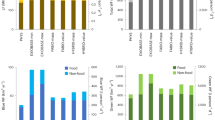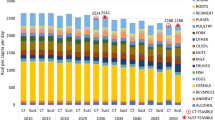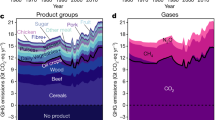Abstract
In order to quantify food resources in the Agrimonde scenarios for each region of the world, quantitative assumptions had to be made on land use, enabling us to define the areas of food production, the food crop yields, and the conversion of plant calories into animal calories. This chapter is devoted to these quantitative assumptions on land occupation. First, the quantification principles adopted will be presented, followed by the assumptions that were formulated for each region and therefore for the world.
Access this chapter
Tax calculation will be finalised at checkout
Purchases are for personal use only
Similar content being viewed by others
Notes
- 1.
“The efficiency of irrigation within a perimeter is the relationship between the volume of water drawn or pumped at the head-end, and the quantity actually used by crops (evapo-transpiration), to which one must add the needs related to maintaining a sheet of water in the case of rice” (CIRAD-GRET-MAE 2002).
- 2.
In the Agrimonde scenarios, six types of area are distinguished: areas with crops and plantations including irrigated land and areas devoted to non-food biomass production, pastures, forests and immerged areas and other (including urban areas, infrastructures, mountains). For more details, see Chap. 2.
- 3.
In its 4th Report, the IPCC Panel 2 foresees a temperature increase of 2 to 3.7 °C in MENA by 2050, depending on the season and the scenario considered (A1FI and B1). Variations in rainfall are wider in B1: − 9 % in March-April-May to + 29 % in September-October-November (IPCC 2007b).
- 4.
Libya and Saudi Arabia use more water for irrigation annually than their renewable resources supply, by drawing on fossil reserves of underground water (FAO 2003a).
- 5.
In the IFPRI-IWMI scenarios, annual growth rates of irrigated areas with cereal crops in MENA range from + 0.10 % in the CRI scenario, to + 0.17 % in the SUS scenario, and + 0.32 % in the BAU scenario, compared to a reference of 9.8 million ha in 1995 (Rosegrant et al. 2002).
- 6.
In the IFPRI-IWMI scenarios, annual growth rates of irrigated areas with cereal crops in SSA range from + 1.11 % in the SUS scenario to + 1.26 % in the CRI scenario and + 1.33 % in the BAU scenario (Rosegrant et al. 2002).
- 7.
The fourth IPCC report does not give projections of changes in temperature and rainfall in 2050. It has however estimated that temperatures could rise by 5 °C in the west of the Sahel and in South Africa up to 2100. Precipitation is likely to become far more erratic, increasing by up to 20 % in the area of Sudan-Ethiopia in the rainy season, and decreasing by as much in the dry season (IPCC 2007c).
- 8.
Michel Griffon proposes a high variant and a low variant for cultivated areas in LAM, as opposed to a single variant for the other regions (Griffon 2006).
- 9.
In the IFPRI-IWMI scenarios, annual growth rates of irrigated areas of cereal crops in LAM range from + 0.76 % in the CRI scenario, to + 0.86 % in the SUS scenario, and + 0.90 % in the BAU scenario (Rosegrant et al. 2002).
- 10.
In the IFPRI-IWMI scenarios the annual growth of irrigated areas under cereal crops in ASIA range from + 0.03 % in the CRI scenario, + 0.23 % in the SUS scenario, and 0.32 % in the BAU scenario (Rosegrant et al. 2002).
- 11.
This assumption is also made by Johnson et al. (2008).
- 12.
The cultivated area per inhabitant will thus be reduced to 0.23 ha in 2050, compared to 0.31 ha in 2000 and 0.51 in 1961.
- 13.
In its fourth Report, the IPCC Panel 2 foresees temperature increases of 3.1 to 6.6 °C in North Asia by 2050, depending on the season and the scenario considered (A1FI and B1). Global rainfall also increases ( + + N in June-July-August in B1 to + 35 % in December-January-February in A1FI). Thus, the climate could become more favourable to agriculture. However in South Asia, the hot and humid climate will intensify, with temperature increases of 0.9 to 3.1 °C, and rainfall increases of 0 to 26 %, depending on the season and the scenario considered (A1FI and B1) (IPCC 2007b).
- 14.
In the IFPRI-IWMI scenarios, figures on irrigated areas under cereal crops in FSU are included in a broader category called “Developed Countries”. This explains why no reference is made to these scenarios in the quantitative assumptions of the Agrimonde 1 scenario.
- 15.
In the IFPRI-IWMI scenarios, the figures pertaining to irrigated areas under cereal crops in the OECD region are included in a larger category “Developed Countries”. This explains why they are not referred to in the quantitative assumptions for the Agrimonde 1 scenario in OECD.
- 16.
The category ‘Other’ corresponds to emerged land other than that under crops, pastures or forests.
Author information
Authors and Affiliations
Corresponding author
Editor information
Editors and Affiliations
Rights and permissions
Copyright information
© 2014 © Éditions Quæ, 2014
About this chapter
Cite this chapter
Ronzon, T. (2014). Land Use in 2050. In: Paillard, S., Treyer, S., Dorin, B. (eds) Agrimonde – Scenarios and Challenges for Feeding the World in 2050. Springer, Dordrecht. https://doi.org/10.1007/978-94-017-8745-1_6
Download citation
DOI: https://doi.org/10.1007/978-94-017-8745-1_6
Published:
Publisher Name: Springer, Dordrecht
Print ISBN: 978-94-017-8744-4
Online ISBN: 978-94-017-8745-1
eBook Packages: Biomedical and Life SciencesBiomedical and Life Sciences (R0)




